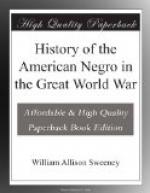“The colored race have been generally considered by their enemies, and sometimes even by their friends, as deficient in energy and courage. Their virtues have been supposed to be principally negative ones.” Speaking of the incidents in Mr. Nell’s collection she says: “They will redeem the character of the race from this misconception and show how much injustice there may often be in a generally accepted idea”. Continuing, she says:
“In considering the services of the colored patriots of the Revolution, we are to reflect upon them as far more magnanimous, because rendered to a nation which did not acknowledge them as citizens and equals, and in whose interests and prosperity they had less at stake. It was not for their own land they fought, not even for a land which had adopted them, but for a land which had enslaved them, and whose laws, even in freedom, oftener oppressed than protected. Bravery, under such circumstances, has a peculiar beauty and merit.
“And their white brothers—may remember that generosity, disinterested courage and bravery, are of no particular race and complexion, and that the image of the Heavenly Father may be reflected alike by all. Each record of worth in this oppressed and despised people should be pondered, for it is by many such that the cruel and unjust public sentiment, which has so long proscribed them, may be reversed, and full opportunities given them to take rank among the nations of the earth.”
Estimates from competent sources state that not less than 3,000 Negro soldiers did service in the American army during the Revolution. Rhode Island first made her slaves free men and then called on them to fight. A black regiment was raised there, of which Colonel Christopher Green was made commander. Connecticut furnished a black battalion under command of Colonel David Humphrey.
Prior to the Revolution, two Virginia Negroes, Israel Titus and Samuel Jenkins, had fought under Braddock and Washington in the French and Indian war.
It has been said that one of the men killed when Major Pitcairn commanding the British advance on Concord and Lexington, April 19, 1775, ordered his troops to fire on the Americans, was a Negro bearing arms. Peter Salem a Negro did service during the Revolution, and is said to have killed this same Major Pitcairn, at the battle of Bunker Hill. In some old engravings of the battle, Salem is pictured as occupying a prominent position. These pictures were carried on some of the currency of the Monumental bank of Charlestown, Massachusetts and the Freeman’s bank of Boston. Other black men fought at Bunker Hill, of whom we have the names of Salem Poor, Titus Coburn, Alexander Ames, Barzillai Lew and Gato Howe. After the war these men were pensioned.




